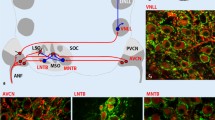Summary
The front legs of the whip spider H. elaphus are strongly modified to serve sensory functions. They contain several afferent nerve fibers which are so large that their action potentials can be recorded externally through the cuticle. In recordings from the tarsus 7 different types of afferent spikes were identified; 6 additional types of afferent spikes were discriminated in recordings from the tibia and femur. Most of the recorded potentials could be attributed to identifiable neurons serving different functions. These neurons include giant interneurons and giant fibers from diverse mechanoreceptors such as slit sense organs, trichobothria, and a joint receptor. In the present report these neurons are characterized using electrophysiological and histological methods. Their functions are discussed in the context of the animal's behavior.
Similar content being viewed by others
Abbreviations
- GN :
-
giant neuron
- S :
-
segment
References
Barth FG (1972a) Die Physiologie der Spaltsinnesorgane. I. Modellversuche zur Rolle des cuticularen Spaltes beim Reiztransport. J Comp Physiol 78:315–336
Barth FG (1972b) Die Physiologie der Spaltsinnesorgane. II. Funktionelle Morphologie eines Mechanorezeptors. J Comp Physiol 81:159–186
Barth FG (1985) Slit sensilla and the measurement of cuticular strains. In: Barth FG (ed) Neurobiology of arachnids. Springer, Berlin Heidelberg New York Tokyo, pp 162–188
Beck L, Foelix RF, Gödeke E, Kaiser R (1977) Morphologie, Larvalentwicklung und Haarsensillen des Tastbeinpaares der Geißelspinne Heterophrynus longicornis Butler (Arach., Amblypygi). Zoomorphologie 88:259–276
Foelix RF (1975) Occurrence of synapses in peripheral sensory nerves of arachnids. Nature 254:146–148
Foelix RF, Choms A (1979) Fine structure of a spider joint receptor and associated synapses. Eur J Cell Biol 19:149–159
Foelix RF, Troyer D (1980) Giant neurons and associated synapses in the peripheral nervous system of whip spiders. J Neurocytol 9:517–535
Foelix RF, Chu-Wang I-W, Beck L (1975) Fine structure of tarsal sensory organs in the whip spider Admetus pumilio (Amblypygi, Arachnida). Tissue Cell 7:331–346
Gnatzy W (1982) “Campaniforme” Spaltsinnesorgane auf den Beinen von Weberknechten (Opiliones, Arachnida). Verh Dtsch Zool Ges 1982:248
Igelmund P (1984) Elektrophysiologische und morphologische Untersuchungen zur Funktion peripherer Riesenneurone in den Tastbeinen der Geißelspinne Heterophrynus elaphus Pocock. Dissertation, Universität zu Köln
Igelmund P (1987) Morphology, sense organs, and regeneration of the forelegs (whips) of the whip spider Heterophrynus elaphus (Arachnida, Amblypygi). J Morphol 193:75–89
Igelmund P (1988) Bristles change their structure during larval development in the whip spider Heterophrynus elaphus: specialization for transduction of wind stimuli? In: Eisner N, Barth FG (eds): Sense organs, interfaces between environment and behaviour. Proc 16th Göttingen Neurobiology Conference. Thieme, Stuttgart New York, p 338
Igelmund P, Wendler G (1991) Morphology and physiology of peripheral giant interneurons in the forelegs (whips) of the whip spider Heterophrynus elaphus Pocock (Arachnida: Amblypygi). J Comp Physiol A 168:75–83
Reißland A, Görner P (1985) Trichobothria. In: Barth FG (ed) Neurobiology of arachnids. Springer, Berlin Heidelberg New York, pp 138–161
Richardson KC, Jarett L, Finke EH (1960) Embedding in epoxy resins for ultrathin sectioning in electron mikroscopy. Stain Technol 35:313–323
Seyfarth E-A (1985) Spider proprioception: Receptors, reflexes and control of locomotion. In: Barth FG (ed) Neurobiology of arachnids. Springer, Berlin Heidelberg New York pp 230–248
Spurr AR (1969) A low-viscosity epoxy resin embedding medium for electron microscopy. J Ultrastr Res 26:31–43
Author information
Authors and Affiliations
Rights and permissions
About this article
Cite this article
Igelmund, P., Wendler, G. The giant fiber system in the forelegs (whips) of the whip spider Heterophrynus elaphus Pocock (Arachnida: Amblypygi). J Comp Physiol A 168, 63–73 (1991). https://doi.org/10.1007/BF00217104
Accepted:
Issue Date:
DOI: https://doi.org/10.1007/BF00217104




